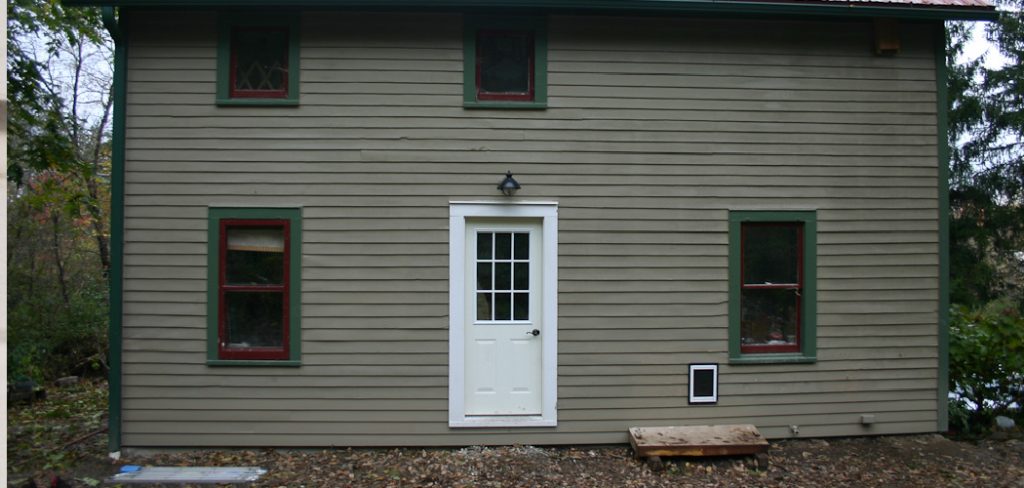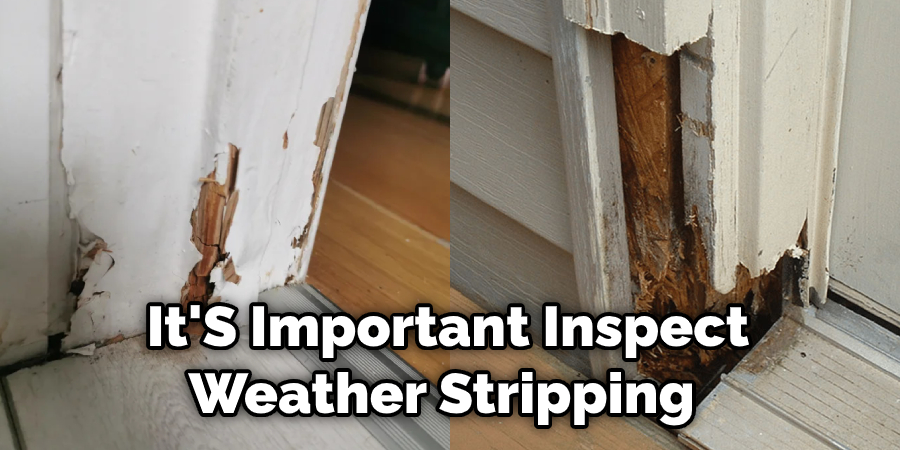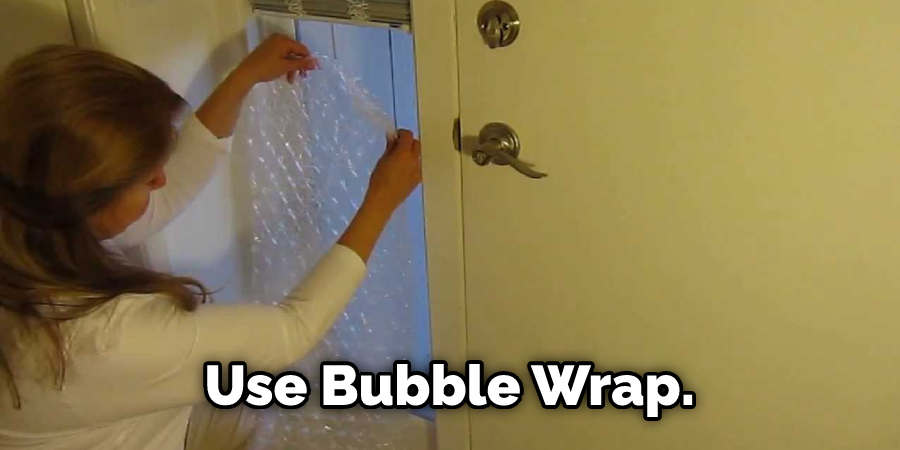For many homeowners, one of the most common annoyances is dealing with air leaks around doors. These pesky leaks can make your home drafty and uncomfortable and can lead to higher energy bills. Luckily, there are a few simple things you can do to fix air leaks around doors. This post will explain what causes these leaks and how to fix air leaks around doors. We’ll also share some tips for preventing air leaks from happening in the first place. Read on to learn more.

Summary: To fix air leaks around doors and prevent energy loss, start by checking the door sweep. Then, install weatherstripping, caulk the door frame, use door snakes and place a door threshold guard. Additionally, install a door bottom seal, hang a curtain in front of the door, use a door draft stopper, place a rug in front of the door, add magnetic tape strips and use bubble wrap.
What Causes Air Leaks Around Doors?
There are a few different things that can cause air leaks around doors, including:
Gaps in the Door Frame
If there are gaps in the door frame, air can easily escape through them. These gaps are often caused by wear and tear or by incorrect installation. It’s important to ensure that your door frame is sealed up tight to prevent air leaks. Gaps can also form around the edges of doors, where the door meets the frame. These gaps can be caused by settling or by the door shrinking or swelling due to changes in temperature or humidity.
Cracks in the Door
If there are cracks in the door itself, air can also escape through them. These cracks can be caused by several things, including weather damage, age, or wear and tear. Inspecting your door regularly and repairing any cracks you find to prevent air leaks is essential. Cracks can also form around the edges of doors, where the door meets the frame.
Poorly Fitted Doors
A door is poorly fitted and may not seal up properly against the frame. This can allow air to escape and make it difficult to close and open the door. Poorly fitted doors are often the result of incorrect installation, but they can also occur over time as the door settles or the frameshifts. Poorly fitted doors can be a major source of air leaks, so it’s important to ensure that yours fits snugly against the frame.
Damaged Weather Stripping

Damaged weather stripping is one of the most common causes of air leaks around doors. Weather stripping is a strip of material that’s used to seal the space between a door and its frame. This strip helps to prevent air leaks and drafts. Over time, weather stripping can become damaged or worn, which can allow air to escape. Therefore, it’s important to inspect your weather stripping regularly and replace it if it’s damaged.
Worn Out Door Sweeps
Door sweeps are strips of material that are attached to the bottom of a door. They help to seal the space between the door and the floor and can prevent air leaks. Door sweeps can become worn out over time, allowing air to escape. It’s important to inspect your door sweeps regularly and replace them if they’re worn out.
Things You’ll Need
- Caulk
- Door sweep
- Screwdriver
- Tape measure
- Weather stripping
Some Effective Ways How to Fix Air Leaks Around Doors:
1. Check the Door Sweep.
The first thing you’ll want to do is check the door sweep. The door sweep is a strip of material that’s attached to the bottom of the door that makes contact with the threshold. Over time, the door sweep can become worn or cracked, which will cause air to leak through. If you notice that the door sweep is damaged, replace it with a new one.
2. Install Weatherstripping.
Weatherstripping is another great way to seal up air leaks around doors. It’s a thin strip of material that’s applied to the door frame and makes contact with the door when it’s closed. This will create a tight seal and prevent air from leaking through. To install weatherstripping, measure the door and cut the weatherstripping to size. Then, apply adhesive to the back of the weatherstripping and press it into place. If you’re unsure how to install weatherstripping, there are plenty of helpful tutorials online.
3. Caulk the Door Frame.

Caulking is another great way to seal up air leaks. It’s a thick, sticky substance that’s applied to cracks and gaps to fill them in. To caulk the door frame, apply a bead of caulk around the door’s perimeter. Next, use a putty knife to smooth it out and ensure no gaps. Then, wait for the caulk to dry completely before closing the door.
4. Use Door Snakes.
Door snakes are long, skinny strips of fabric that are placed at the bottom of doors to seal up gaps. They’re usually made from a heavy-duty material like denim or canvas, which makes them great for preventing air leaks. To use a door snake, place it at the bottom of the door before closing it.
5. Place a Door Threshold Guard.
A door threshold guard is a piece of metal or plastic placed over a door’s threshold. It helps seal any gaps between the door and the threshold, preventing air from leaking through. To place a door threshold guard, measure the threshold and cut the guard to size. Then, attach it to the threshold with screws or adhesive. Door threshold guards are easy to install and can be found at most hardware stores.
6. Install a Door Bottom Seal.
A door bottom seal is a strip of rubber or plastic placed at the door’s bottom. It helps seal any gaps between the door and the floor, preventing air from leaking through. To install a door bottom seal, measure the door and cut the seal to size. Then, attach it to the bottom of the door with screws or adhesive. Door bottom seals are easy to install and can be found at most hardware stores.
7. Hang a Curtain in Front of the Door.
If you don’t want to go through the hassle of installing door snakes or weatherstripping, you can hang a curtain in front of the door. This will create a barrier that will prevent air from leaking through. Measure the door and cut the curtain to size to hang curtain. Then, attach it to the door frame with screws or adhesive. If you’re not sure how to hang a curtain, there are plenty of helpful tutorials online.

8. Use a Door Draft Stopper.
A door draft stopper is a long, skinny tube that’s filled with sand or rice. It’s placed at the bottom of doors to seal up gaps and prevent air from leaking through. To use a door draft stopper, place it at the bottom of the door before closing it. Then, when you want to open the door, lift it up and out of the way. Door draft stoppers are easy to use and can be found at most hardware stores.
9. Place a Rug in Front of the Door.
If you don’t want to go through the hassle of installing door snakes or weatherstripping, you can place a rug in front of the door. This will create a barrier that will prevent air from leaking through. To place a rug, measure the door and cut the rug to size. Then, please attach it to the floor with adhesive or tape. If you’re not sure how to place a rug, there are plenty of helpful tutorials online.
10. Add Magnetic Tape Strips.
Magnetic tape strips are a great way to seal up gaps and prevent air from leaking through. They’re easy to use and can be found at most hardware stores. To use magnetic tape strips, place them on the doorframe and close the door. The magnets will hold the strips in place and seal up any gaps. If you’re not using a door sweep, you can also place magnetic strips on the bottom of the door. This will help to seal up any gaps between the door and the floor.
11. Use Bubble Wrap.
Bubble wrap is a great way to seal up gaps and prevent air from leaking through. It’s easy to use and can be found at most hardware stores. To use bubble wrap, simply place it on the doorframe and close the door. The bubbles will help to seal up any gaps. Of course, if you’re worried about the bubble wrap being visible, you can always place it inside the door.

How Much Does It Cost to Fix Air Leaks Around Doors?
The cost of fixing air leaks around doors will vary depending on the size of the door, the type of door, and the severity of the leaks. However, most people can expect to spend between $50 and $100 on materials and labor. If you’re handy, you may be able to save some money by doing the work yourself.
Frequently Asked Questions
Why Is There a Gap under My Door?
There might be a gap under your door because of loose weather striping or the caulking sealant has failed. If this is the case, you’ll need to call a professional to take care of it. A gap like this can lead rain and snow into your home, which can cause mold and other problems.
Should Carpet Touch the Door?
the decision of whether or not to carpet touch the door will be based on your individual needs and preferences. However, there are a few things that you should keep in mind when making this decision. First, if you have pets or children who might knock over objects while they’re playing outside, it may be helpful to cover the floor with a rug instead of carpeting it.
Secondly, if your carpets are often dirty due to pet hair and allergies (as is common in some homes), then it may be best not to carpets touch the door at all. Instead, put down wood floors or tiles so dirt and dust don’t get tracked onto the carpets.
What Is the Border around a Door Called?
the border around a door can vary depending on the style of the door, its construction, and the area in which it is located. However, a few general tips that might help include referring to the door’s manufacturer for guidance, measuring the area around the door to ensure that it fits within the specified border, and using a professional contractor if necessary.
Can See Light around Exterior Door?
it depends on the type of door and how well-lit it is. Generally speaking, if you can see a clear line around the edge of your door from one side to the other, then the light may be able to escape. If you cannot see a clear line around the edge of your door or if there appears to be too much light coming in from outside, consider installing an opaque curtain or shade over your front window.
Conclusion
This article has provided a comprehensive guide on how to fix air leaks around doors. Following the tips and advice above can help keep your home warm and comfortable during the winter months. If you have any questions or concerns, write them in the comments below. We’ll be happy to help you out. Thanks for reading!
You May Also read: How to Fix Door Frame Pull Up Bar
